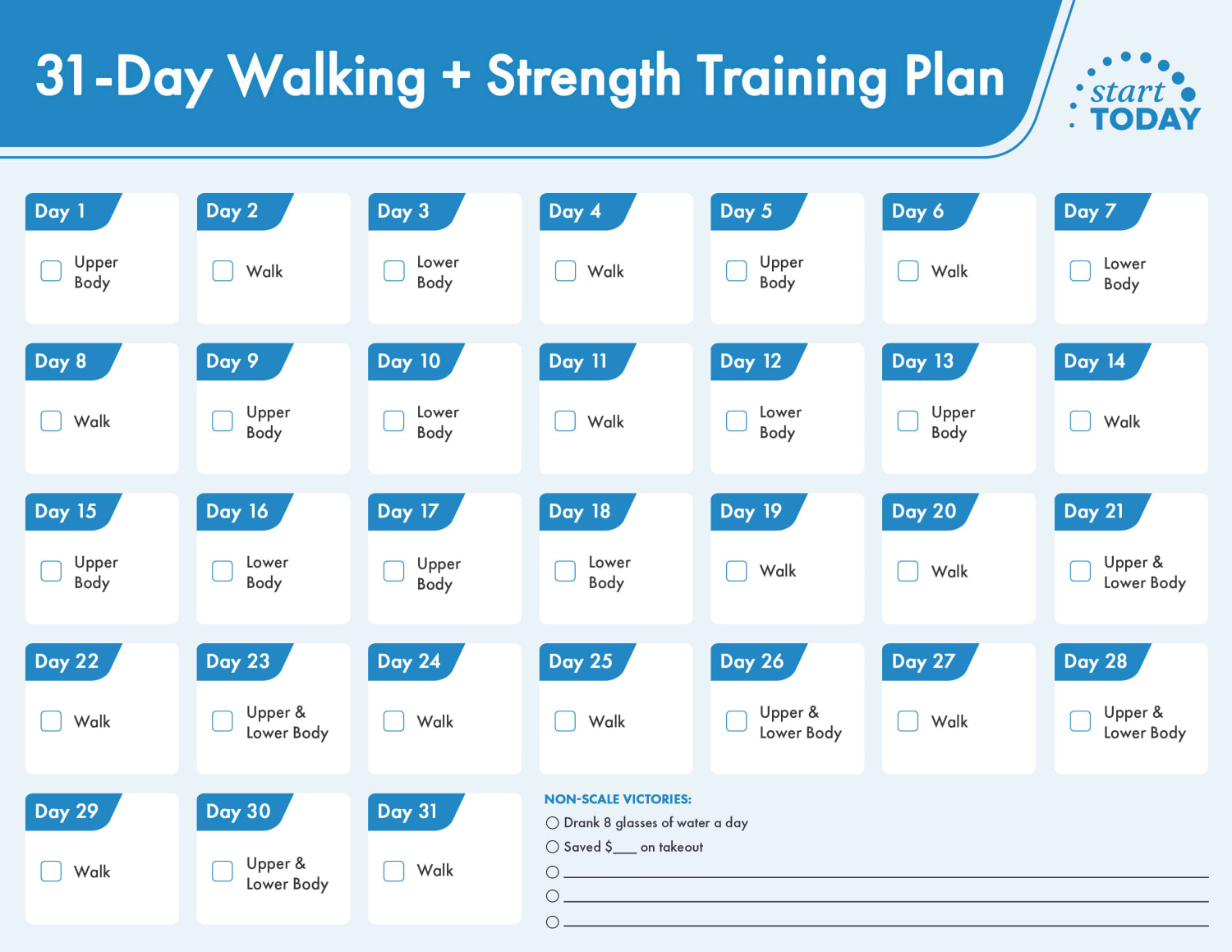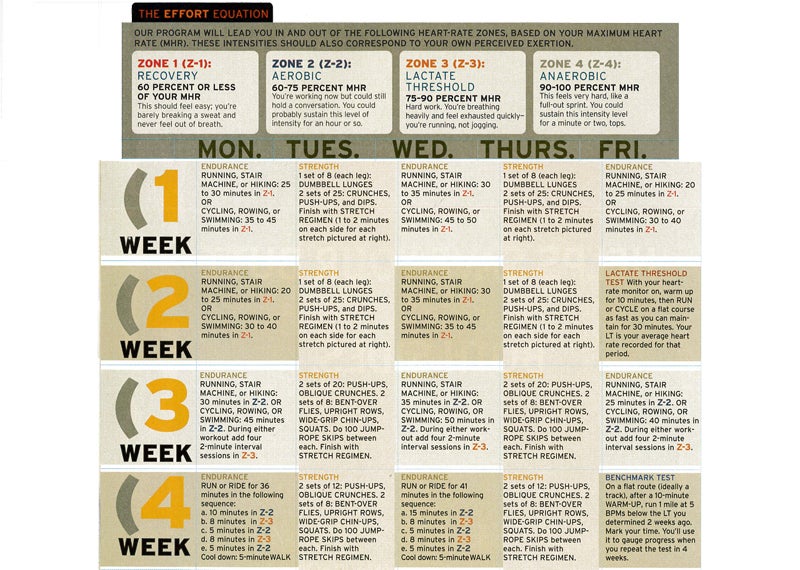A Strength and Endurance Workout Plan combines resistance training with cardiovascular activities to build muscle and stamina. This regimen typically involves weightlifting, bodyweight exercises, and aerobic workouts.
Embarking on a fitness journey that targets both strength and endurance offers a holistic approach toward overall health and performance. Such a workout plan caters to those aiming to fortify their muscles while enhancing their heart and lung capacity. It strikes a balance between lifting, often with progressive overload to challenge the muscles, and consistent cardio to boost aerobic capabilities.
This dual-focus approach not only amplifies physical prowess but also contributes to better body composition, increased energy levels, and heightened endurance. Effectively designed plans prioritize proper form, balanced routines, and adequate recovery periods to prevent injury and ensure sustainable progress. Embracing this type of training regime can be transformative, offering benefits that transcend the gym and permeate everyday life activities.

Credit: www.today.com
Initial Steps To Stamina Building
Embarking on a journey to bolster stamina and muscle power? Starting with a robust plan is key. Before hitting the gym or trail, first understand where you stand and what you aim to achieve. Let’s tackle the initial steps to building your strength and endurance, paving the way for a fitter you.
Assessing Your Current Fitness Level
Begin with a snapshot of your starting point. Gauge your fitness level to see how much ground you need to cover.
- Check your Resting Heart Rate: A low resting heart rate indicates a strong cardiovascular system.
- Count your Push-Ups: Push-ups reveal upper body strength and endurance.
- Time a Run or Walk: See how long it takes to cover a set distance; it reflects your stamina.
- Body Composition Analysis: Not just about weight, but muscle to fat ratio matters too.
Document these baseline metrics for future comparison.
Setting Realistic Goals For Strength And Endurance
Goal setting turns ambitions into trackable targets. Establish achievable milestones for motivation and progress tracking.
| Timeframe | Strength Goal | Endurance Goal |
|---|---|---|
| 4 Weeks | Master 20 push-ups | Run 1 mile non-stop |
| 8 Weeks | Bench press 50% body weight | Run 5k without pauses |
| 12 Weeks | Perform 5 pull-ups | Complete a 10k jog |
Align your goals with personal interests and everyday life. This ensures your plan stays fun and feasible.

Credit: www.today.com
Key Principles Of A Strength And Endurance Routine
Building both strength and endurance requires a smart plan that balances key principles. Understanding and applying these principles helps achieve better fitness results. Let’s dive into what makes a successful strength and endurance routine.
Balancing Intensity And Volume
The balance between how hard you work and how much you do is crucial. Intensity refers to the weight or resistance level. Volume is about the number of reps and sets. A well-planned workout alternates between high-intensity sessions with more weight, and high-volume sessions with more repetitions. This prevents burnout and encourages steady progress.
Importance Of Progressive Overload
Progressive overload is a method where you gradually increase the stress on your body during exercise. This increases your muscle strength and endurance over time. To practice this, you can add more weight, increase reps, or reduce rest time between sets. Tracking your workouts helps you apply this principle effectively.
Essential Components Of Your Workout
A well-rounded strength and endurance workout plan does wonders for your fitness goals. It helps boost your energy, build muscle, and improve heart health. Every workout plan should include two main parts: resistance training and cardiovascular exercises. These parts work together to build a powerful routine that maximizes your results. Let’s dive into what each component entails.
Incorporating Resistance Training
Resistance training strengthens muscles by making them work against a force. This force could be weights, bands, or your bodyweight. The benefits are vast, from improving muscle tone to boosting metabolism.
- Choose the right weight—It should challenge your muscles without causing strain.
- Mix up exercises—Target different muscle groups to promote balanced strength.
- Focus on form—Proper technique prevents injuries and ensures effectiveness.
Plan for two to three days of resistance training per week. Always allow rest days for muscles to recover.
Integrating Cardiovascular Exercises
Cardio exercises raise your heart rate and improve lung capacity. They are key to burning calories and building endurance. Options like running, cycling, and swimming are popular.
- Start with a warm-up—Prepare your body to prevent injury.
- Vary the intensity—Include both high-intensity intervals and steady-pace sessions.
- Consistency is key—Aim for 150 minutes of moderate cardio or 75 minutes of vigorous cardio each week.
Combine these exercises with resistance training for the best results. Make sure to balance work with rest; your body needs it to rebuild and get stronger.
| Day | Activity | Intensity | Duration |
|---|---|---|---|
| Monday | Resistance Training | Moderate | 30 minutes |
| Wednesday | Cardiovascular Exercise | High | 20 minutes |
| Friday | Resistance Training | Moderate to High | 30 minutes |
Follow this simple yet effective workout plan to see noticeable improvements in both strength and endurance. Remember, balance and consistency are the keys to a successful fitness journey.
A Week’s Sample Workout Plan
Finding the right balance of intensity and recovery is key in a strength and endurance workout plan. With this thoughtfully structured week-long sample, you’ll push your limits and give your body the necessary time to recover. Embrace the challenge and prepare to grow stronger.
Day-by-day Breakdown
Streamline your fitness journey with a planned schedule that progresses through the week. Maximize gains by following this daily guide:
- Monday: Full-body Strength Training
- Tuesday: High-Intensity Interval Training (HIIT)
- Wednesday: Active Recovery (Light Cardio)
- Thursday: Lower Body Strength + Endurance
- Friday: Upper Body Strength + HIIT
- Saturday: Long Duration Cardio
- Sunday: Rest and Recovery
Variations And Modifications
Adapt and overcome any limitations with modifications. Ensure progress regardless of fitness level:
| Day | Variation | Modification for Beginners |
|---|---|---|
| Monday | Bodyweight Exercises | Reduce Sets/Reps |
| Tuesday | Low-Impact HIIT | Increase Rest Intervals |
| Wednesday | Gentle Yoga | Shorten Duration |
| Thursday | Resistance Bands | Lighter Weights |
| Friday | Kettlebell Workouts | Fewer Rounds |
| Saturday | Cycling | Decrease Intensity |
| Sunday | Guided Stretching | Focus on Comfort |
Dietary Considerations For Optimal Performance
Your diet plays a crucial role in fueling your workouts and aiding recovery. A smart nutrition plan ensures you have the right balance of macronutrients and micronutrients to help you perform at your peak while building strength and endurance. Next, we’ll dive deep into the dietary essentials that support muscle recovery and sustained energy levels during intense training sessions.
Nutritional Needs For Muscle Recovery
After pushing your limits, your muscles crave nutrients to repair and grow stronger. Focus on these key components:
- Protein: Vital for muscle repair. Aim for lean sources like chicken, fish, and plant-based alternatives.
- Carbohydrates: Replenish glycogen stores with whole grains, fruits, and vegetables.
- Fats: Don’t fear good fats; avocados, nuts, and seeds support overall health.
- Antioxidants: Combat workout-induced oxidative stress with berries, leafy greens, and other colorful produce.
Hydration And Energy Maintenance
Maintaining hydration levels is essential for your performance, as even slight dehydration can impair your abilities. To stay energized, keep these tips in mind:
| Before Workout | During Workout | After Workout |
|---|---|---|
| Drink 17-20 ounces of water. | Sip on water or an electrolyte drink. | Rehydrate with 16-24 ounces of fluid for every pound lost. |
Complex carbs will fuel your sessions, while simple sugars are beneficial post-workout for quick energy replenishment.
Recovery Strategies To Enhance Progress
A solid workout plan is not just about the exercises you do; it’s about the pauses in between. Recovery strategies are crucial for making consistent progress in your strength and endurance goals. These strategies help your muscles heal and grow stronger. Let’s dive into the best ways to rest and actively recover, so you can get back to training harder and smarter.
Understanding Rest And Recovery
Rest days are essential for muscle repair, strength building, and endurance improvement. Without enough rest, the body can’t recover fully, which might lead to injuries. It’s important to note:
- Sleep is the top priority in recovery.
- Your body needs at least one full rest day each week.
- Nutrition and hydration play a significant role in how quickly you recover.
Create a rest schedule that aligns with your workout intensity. Pay attention to your body’s signals. Feeling sore or tired often means you need more recovery time.
Active Recovery Techniques
Active recovery involves doing low-intensity exercise after a heavy workout. This type of recovery can:
- Boost blood circulation
- Enhance flexibility
- Reduce muscle soreness
Try incorporating these active recovery exercises into your routine:
| Activity | Benefits |
|---|---|
| Yoga | Increases flexibility and reduces stress |
| Light Jogging | Improves blood flow and clears lactic acid |
| Swimming | Low-impact cardio that eases joint strain |
Choose activities that you enjoy and that feel rejuvenating. Keep the intensity down and pay attention to your body. Remember, the goal of active recovery is to facilitate healing, not add stress to your body.
Tracking Progress And Adjusting Your Plan
Every fitness journey thrives on the power of monitoring achievements and fine-tuning strategies. A strong and enduring body demands a workout plan that adapts as muscles evolve. Here’s how to track your progress and tweak your routine for optimal results.
Monitoring Workouts And Body Response
Understanding your body’s signals is key to an effective workout plan. By keeping a close eye on every exercise session, you spot trends and patterns. This insight helps tailor a plan that fits you like a glove.
- Log your workouts: reps, sets, weights.
- Note down how you feel post-workout.
- Check your rest and recovery times.
- Watch changes in strength and endurance levels.
Regularly use these data points to guide your next moves. A digital tracker or a simple notebook can become your best ally in this pursuit.
When To Ramp Up Intensity
Advancement is a clear sign of progress but knowing when to step up the workout game is crucial. Here’s a simple guide:
- Repetitions become too easy? Increase the weight or resistance.
- Resting heart rate declines over time? Your cardiovascular system is stronger.
- Muscles recover quickly? It’s time for more challenging exercises.
- No change in endurance? Introduce interval training to shake things up.
Always listen to your body and consult with a professional before making significant changes. They ensure your safety and drive toward peak performance.
Avoiding Common Pitfalls
Building strength and endurance requires careful planning. With the right workout plan, you can see big changes. But there are traps along the way. Let’s look at common mistakes and how to dodge them.
Overtraining Signs And Symptoms
Working out too hard can backfire. Your body needs rest to grow stronger. Watch out for these red flags:
- Muscle soreness that won’t go away
- Feeling exhausted instead of energized
- Sleep troubles
- Getting sick often
- Loss of motivation or interest
If you spot these signs, take a break. Your body needs it.
Balance And Consistency In Training
Steady progress beats quick fixes. Aim to mix it up. Include:
| Activity | Purpose |
|---|---|
| Cardio | Builds endurance |
| Weight Training | Increases strength |
| Rest | Allows recovery |
Balance these elements across your week. Keep a regular schedule. Your body will thank you.
Advanced Training Techniques For Seasoned Athletes
Advanced Training Techniques for Seasoned Athletes push experienced competitors to new heights. With a focus on enhancing strength and endurance, these cutting-edge workout strategies elevate performance in a dynamic way.
Incorporating Hiit And Circuit Training
High-Intensity Interval Training (HIIT) packs a powerful punch in short bursts. Seasoned athletes use this approach to amplify fat burn and boost cardiovascular health.
- Intense work phases of 20-60 seconds
- Rest intervals just as brief
- Repetitions vary based on fitness level
| Activity | Duration | Intensity |
|---|---|---|
| Sprints | 30 sec | Max effort |
| Rest | 30 sec | Low |
| Burpees | 30 sec | Max effort |
Circuit Training switches between exercise stations. Athletes target different muscle groups with minimal rest, which improves muscular endurance.
- Squat jumps
- Push-ups
- Planks
- Boxing punches
Periodization For Peak Performance
Periodization divides training into distinct phases. Each phase focuses on specific fitness goals. This approach optimizes performance and avoids plateaus.
Key elements include:
- Macrocycle:
- The overall training period, usually a year.
- Mesocycle:
- Divisions within the macrocycle (e.g., pre-season, in-season).
- Microcycle:
- Weekly training breakdowns guiding intensity and volume.
Variation in workouts prevents stagnation. Tactics can involve changing exercises, intensity, volume, or rest periods. Structured variation leads to significant gains in strength and endurance.
For tabled clarity, see the below example of a periodized training week:
| Day | Focus | Intensity |
|---|---|---|
| Monday | Strength | High |
| Wednesday | Endurance | Medium |
| Friday | Power | Low |

Credit: www.walmart.com
Maintaining Motivation And Commitment
Embarking on a strength and endurance workout plan requires more than just physical exertion. It demands consistent motivation and commitment. The thrill of starting a new routine fades fast. Sustaining energy levels throughout is crucial. Read on for surefire strategies to stay committed and keep your training on track.
Setting New Challenges And Milestones
Breaking monotony fuels workout dedication. Regularly introducing fresh challenges prevents boredom and burnout. Consider these methods for staying enlivened:
- Increase intensity: Gradually add more weight or resistance.
- Switch exercises: Rotate between different moves to target various muscle groups.
- Time-bound goals: Aim for a specific achievement, like a faster 5K, within a set timeframe.
Achieving these micro-goals sparks joy and the urge to push onward.
Leveraging A Support System
Workout journeys should not be solitary. Leverage the power of camaraderie:
- Workout buddies: A gym partner increases accountability.
- Online communities: Share progress in fitness forums and groups.
- Personal trainer: A coach offers expertise and encouragement.
Encouragement from others amplifies commitment. Exchange tips, celebrate wins, and tackle hurdles together for a stronger resolve.
Frequently Asked Questions On Strength And Endurance Workout Plan
Can You Combine Strength And Endurance Training?
Yes, you can combine strength and endurance training. Alternate sessions for optimal results and allow adequate recovery time. Balance both types to achieve your fitness goals without overtraining.
How Do You Work Out Strength And Endurance?
To build strength and endurance, consistently combine weightlifting with cardiovascular exercises. Prioritize compound movements, like squats and push-ups, and gradually increase intensity. Include interval training, such as HIIT, for endurance. Rest and nutrition are crucial for recovery and performance.
Can You Do Strength And Endurance Training On The Same Day?
Yes, you can do strength and endurance training on the same day. Schedule strength work before endurance to maximize muscle gains, and allow adequate recovery between the sessions.
How Long Should A Strength Or Endurance Workout Be?
A strength workout typically lasts 45 to 60 minutes, while endurance sessions can range from 20 to 60 minutes. Tailor the duration to match your fitness goals and capacity.
Conclusion
Embracing the journey to strength and endurance need not be daunting. Start simple, stay consistent, and your resilience will grow. Remember, each workout propels you closer to your peak fitness. So lace up, focus on your goals, and let every sweat drop chart your path to a stronger, more enduring you.
Let’s crush those workouts!

I am a health writer and blogger based in the US and UK. I have been with the health department for six years. And I give advice on various health problems and solutions. I have a lot of experience in health matters and I share it here.

